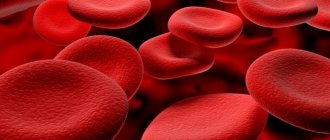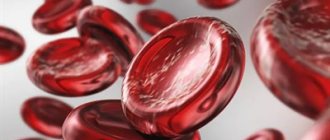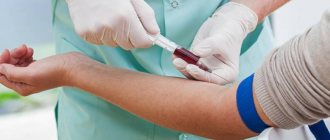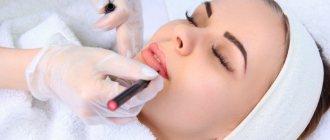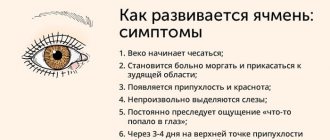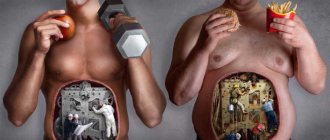1
Author of the article: Marina Dmitrievna
2017.10.01
2 159
Hemoglobin
In classic novels, romantic young ladies often faint due to emotional excitement. Today's girls and women are not so romantically nervous, but they also have fainting spells. They are caused by a completely prosaic reason - there is not enough oxygen for the brain cells.
Transporting oxygen is the main function of hemoglobin
There is not enough oxygen because there is not enough oxygen in the blood of its main carrier, hemoglobin. It is an iron-containing protein that red blood cells are literally packed with. It is because of this that our blood is red.
Newborns have the most hemoglobin
Reduced hemoglobin: reasons
The human body loses iron-containing protein for a number of reasons. The most common are the following:
- Blood loss, which is divided into: obvious, i.e., visible loss of blood by the body due to abdominal operations, wounds, serious injuries, advanced hemorrhoids, heavy menstruation in women; hidden – the development of internal bleeding with the progression of diseases of the gastrointestinal tract.
- Low content of vitamins and amino acids, which are necessary for the process of hemoglobin synthesis. If the body does not have enough vitamin C or folic acid, this is due to an unbalanced, poor diet.
- Vitamin B12 deficiency, which is possible due to helminthic infestation.
- Problems with the digestive system: gastritis, colitis, ulcers. These ailments interfere with the absorption of iron, due to the depletion of the mucous membrane of the gastrointestinal tract.
- Infectious diseases of a severe nature: hepatitis, tuberculosis, etc. The pathological processes that accompany these diseases lead to the premature death of red cells in the blood. As a result, a person's hemoglobin may drop below 50 g/l.
- Hypothyroidism is a severe syndrome that is caused by decreased levels of hormones in the thyroid gland. It is hormones that regulate the absorption of iron in the intestines; accordingly, when they are deficient, hemoglobin decreases.
- Autoimmune diseases that lead to damage and destruction of normal tissues.
- A malignant blood disease causes hemoglobin levels up to 50 g/l.
- The presence of neoplasms in internal organs.
- The presence in life of stressful situations that, depressing the psyche, can make a person feel depressed. Negative emotions disrupt metabolic processes, affecting a decrease in hemoglobin.
- Imbalance in nutrition. Harm can occur not only due to insufficient intake of necessary beneficial elements and substances into the body. There are also a number of products that, when consumed in large quantities, can cause a decrease in hemoglobin. These include: strong coffee, tea, chocolate, cereals. All these products inhibit the absorption of iron.
- Low physical activity, which can serve as a catalyst in slowing down the movement of blood through arteries, veins and capillaries. At this moment, the human brain receives a signal that says that there are enough red blood cells in the body, so there is no need to produce them.
A natural reason for a low level of iron-containing protein is constant donation. If the person is healthy, then in this case everything will quickly recover, but if the hemoglobin does not return to normal, then the medical staff refuses the services of this donor.
Causes of low hemoglobin and factors influencing its norm
Normal hemoglobin (Hb) values in men by age:
- for men from 18 to 65 years old - 130-170 g/l;
- for men over 65 years old - 120-170 g/l.
Indicators depend on several factors that may influence test results. For example, the concentration of heme protein changes after exercise or intense training. But changes are also recorded in people living in high mountain areas, in pilots, climbers, smokers, and donors.
Throughout life, indicators may change up or down due to various factors. Most often, a decrease in the level of hemoglobin in the blood is recorded. Many reasons can provoke the appearance of low hemoprotein in an adult man. These include:
- unbalanced and insufficient nutrition;
- hidden and obvious blood loss;
- intestinal diseases that interfere with the absorption of iron;
- diseases of the gastrointestinal tract (ulcers, erosions, gastritis, colitis);
- endocrine disorders;
- malignant and benign neoplasms;
- pathologies of the hematopoietic system;
- extensive burns.
Attention! Low hemoglobin requires correction with medications.
In men, low Hb is sometimes associated with genetic predisposition and a passive lifestyle. Lack of activity leads to a drop in the hormone testosterone, which causes a decrease in the concentration of hemoprotein.
Symptoms of the disease

A decrease in hemoglobin to 50 g/l has the following symptoms:
- Subjective – it is evidenced by the patient’s complaints.
- Objective, which is measured quantitatively.
Subjective asthenic symptoms include:
- insomnia at night along with drowsiness during the day;
- weakness throughout the body;
- heavy morning rise, in which a person requires effort to get up;
- noise in ears;
- increased fatigue;
- frequent migraines;
- dizziness, sometimes fainting and fainting;
- menstrual irregularities;
- decreased appetite, up to complete aversion to food;
- decrease in potency.
All these symptoms appear due to a lack of oxygen in the tissues, and as a result, disturbances in the pH level of the cells occur.
Subjective dystrophic symptoms
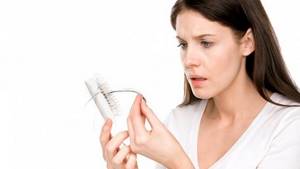
You can also identify subjective dystrophic symptoms, which are signs of iron deficiency and are indirect in nature:
- the nail plates are affected: they delaminate, become thinner, break, and stains and fungal diseases may appear;
- hair deteriorates: it falls out, hardly grows, splits, becomes faded and brittle.
- disturbance of taste and smell, a desire may also appear to eat something inedible (sand, chalk, sulfur, toothpaste, raw minced meat, raw cereals, etc.), the smells of naphthalene, acetone, varnish begin to attract;
- the skin becomes dry and pale;
- some report tingling in the feet;
- spasms of the lower extremities occur;
- slight increase in body temperature.
All these symptoms may be present even with a slight decrease in hemoglobin; in cases where it has been reduced for a long period, objective symptoms include:
- tachycardia, which is accompanied by a significant increase in pulse rate;
- low blood pressure;
- heart murmurs.
If hemoglobin has decreased relatively recently, then the person primarily feels only weakness, fatigue or vitamin deficiency. In this regard, it is better to take a blood test several times a year in order to prevent subsequent painful consequences.
Symptoms of decreased hemoglobin
Hypoxia is a pathological condition that develops against the background of a decrease in iron-containing protein. As a result, men suffer from a whole range of symptoms that affect their general condition. First of all, they are expressed as:
- insomnia;
- apathy;
- increased fatigue;
- constant weakness;
- dizziness;
- chronic headaches;
- cracks in the corners of the lips;
- pale and dry skin;
- disturbances of taste and smell.
Most often, the listed clinical manifestations are recorded in autumn and spring, when the body experiences a deficiency of vitamins and microelements. With a slight increase, signs of anemia are reversible. If symptoms progress, there is a risk of serious consequences.
The danger of anemia and consequences
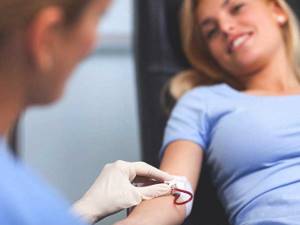
According to statistics, a third of the world's population suffers from iron deficiency anemia. This disease is especially common among women and children. There are several forms of anemia:
- Mild, in which iron-containing protein in the blood is 90-120 g/l.
- Average – up to 60 g/l.
- Severe - in this case the level drops below 60 g/l.
When hemoglobin decreases to 50 g/l, there may be a threat of acidosis - this is a shift in the acid-base balance in the body towards an increase in acidity. This condition is extremely dangerous, since over time it will lead to depression of both cardiac activity and respiratory centers.
If low hemoglobin is present for a long time in a severe form, problems with the human immune system are possible. The most common cold in this case will be difficult, with the possibility of complications. Gradually, the body loses its defense function against harmful microbes and organisms, which undoubtedly poses a great threat to health and sometimes life.
Features of the disease in men and women
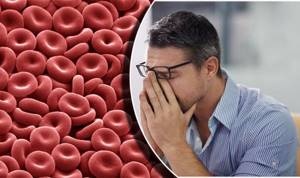
In adults of different sexes, anemia manifests itself with similar symptoms, but it also has its own characteristics. With hemoglobin 50, a man experiences a decrease in virility and sometimes temporary impotence. In the fair half of humanity, the menstrual cycle is generally always disrupted, sometimes menstruation stops altogether.
One of the reasons for hemoglobin 50 in a woman may be pseudo-loss of blood, which occurs with diseases of the female organs such as uterine fibroids and the presence of cysts on the ovaries. All neoplasms have the specificity of being filled with blood, the resorption of which occurs slowly. But the function of hemoglobin cannot be fulfilled, since it is converted into another compound.
Hemoglobin - what is it?
A vital blood protein , which is the pigment for red blood cells (red cells), is called hemoglobin.
- iron porphyrin (heme) ions, which give the blood its characteristic rich red color;
- colorless protein component (globin).
The main function of hemoglobin is the transport of oxygen and carbon dioxide between the lungs, organs and tissues of the human body, ensuring stable metabolism.
About low hemoglobin on video
Pregnancy and anemia

The most common reason for a decrease in hemoglobin to 50 in women is pregnancy. This condition raises concerns for the health of both the mother and the unborn child.
The danger of such a disease is as follows:
- development of uterine hypotension (decreased tone and ability to contract);
- hypoxia (lack of oxygen for the child);
- the placenta is not positioned correctly;
- intrauterine growth retardation or cessation of development.
A child may be born with pathologies:
- low weight;
- underdevelopment;
- disorders of the nervous and respiratory systems;
- atrophy of individual organs and muscles;
- deviation in physical and mental development, the manifestation of which is possible after several months or even years.
Considering the seriousness of this condition, pregnant women are required to carefully monitor their health by visiting doctors. If possible, even when planning a pregnancy, you should improve your health in order to prevent negative consequences.
Preventive actions
Prevention of decreased hemoglobin includes the following recommendations:
- balanced and proper nutrition, you need to consume more foods fortified with iron and other vitamins;
- lead a healthy and active lifestyle, quit smoking and alcohol;
- engage in a feasible sport;
- spend more time in the fresh air;
- avoid stress and emotional stress;
- observe a rest and wakefulness regime;
- avoid contact with harmful chemicals;
- if bleeding develops, it is necessary to quickly stop the bleeding;
- do not self-medicate, take any medications only with the permission of a doctor;
- treat infectious diseases in a timely manner.
To prevent the development of anemia and to detect it in time, it is necessary to undergo a diagnostic examination and a general blood test twice a year. Medical control is especially important for men over 60 years of age.
Hemoglobin is the most important blood indicator. It is extremely important to maintain normal iron protein levels throughout your life. In men, a decrease in its level is more often recorded, which negatively affects overall well-being. Without treatment, the consequences can be unpredictable. Therefore, even a slight decrease requires adjustment with diet, medications, and folk remedies.
Anemia in children

In children, this disease is associated with various pathologies or a lack of vitamins and minerals in the body. Anemia is dangerous for a child due to weakened immunity: the body is vulnerable to various types of infections. Also, this disease can have an impact on the deterioration of physical and mental health. It is important to monitor your blood composition from birth and follow all doctor’s recommendations.
For a child's body under 18 years of age, the norms for iron-containing protein differ only by age; gender characteristics do not play a role, unlike in adults. The norm for a baby at 1-2 weeks is considered to be 125-206 g/l, at 1 year – 105-146 g/l. Further, the hemoglobin level increases by 1-3 g/l and by 6-8 years it reaches 110-150 g/l, and from 14 to 18 years – 115-160 g/l.
The consequences of low hemoglobin levels and why they are dangerous
Why is low hemoglobin dangerous for women? If the level of hemoglobin decreases significantly, all tissues of the body begin to experience oxygen deficiency, which affects the functioning of almost all organs and systems, disrupting their normal functionality. First of all, the human brain and nervous system suffer from a lack of oxygen, which explains the appearance of feelings of fatigue, drowsiness, dizziness and fainting.
Due to the lack of oxygen in the tissues, the functioning of other organs is also disrupted, but a person rarely feels this, since most of them do not contain nerve endings, and, therefore, cannot signal the presence of disorders by the appearance of pain. But at the same time, the hidden appearance of many diseases begins.
An important point is that a strong decrease in hemoglobin levels leads to a sharp deterioration in the functioning of the immune system , which reduces natural protective functions and the body becomes susceptible to all kinds of infections.
During the period of gestation, a decrease in this substance can lead to serious consequences, in particular, to too low a baby’s birth weight, intrauterine hypoxia, delayed development of the fetus (both physical and mental, which will manifest itself later), and cause systemic dysfunction in the baby breathing, reduce labor activity due to uterine hypotension.

Many women do not realize the consequences of a decrease in hemoglobin in the blood, and try not to pay attention to obvious signs of a lack of substance. In the case when the hemoglobin level is reduced for a long time, the general situation in the body worsens, which can provoke the development of many ailments.
Therefore, if you notice any symptoms indicating a decrease in hemoglobin, you should consult a doctor and take a blood test to check the indicators in order to take the necessary measures in time.
Signs of anemia in children

It is not easy for parents to identify this disease on their own. Poor appetite, fatigue, drowsiness, and absent-mindedness are perceived by them as a temporary feature and do not attract close attention. But at this time there is a possibility of metabolic disorders occurring.
Signs of anemia include:
- pallor, weakness;
- poor weight gain or no weight gain at all;
- dizziness;
- slow growth;
- frequent ARVI;
- changeability of behavior.
Such symptoms do not always indicate this disease, but it would still be useful to donate blood for a test. If an adult’s hemoglobin level decreases to 50 g/l, then a blood transfusion cannot be avoided. For children under one year old, the critical level is 85 g/l, after one year it is 70 g/l. Reduced hemoglobin is often recorded in overly active children.
Treatment methods
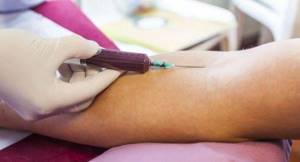
In order to begin treatment, it is important to try to identify the exact cause of the pathology and try to exclude it. Therapeutic measures should be aimed at both normalizing the color index, the level of iron-containing protein, and restoring the concentration of iron in the blood depot and serum.
In the presence of micro- or macrobleeding, the following are often indicated:
- correction of uterine bleeding;
- removal of hemorrhoids;
- surgical removal of fibroids;
- therapy of gastritis, enteritis, ulcers and other housing and communal services diseases.
Pathogenetic methods of treating low hemoglobin up to 50 g/l include the doctor’s prescription of drugs with B vitamins (“Neurobeks”, “Neurobion”, “Kombilipen”) and iron (“Aktiferrin”, “Maltofer”, “Ferkail”). They can be taken as tablets or syrup, but injections are more effective. The dose of medication is strictly prescribed by the doctor. It should be sufficient, but in no case excessive, so as not to cause intolerance to the drug.
In order to increase a woman’s hemoglobin from 50 g/l to normal, if the decrease has unknown etiological factors (heavy menstruation, uterine bleeding, etc.), the doctor develops anti-relapse therapy for chronic anemia. Often, with such a low value, a blood transfusion is necessary, but sometimes doctors manage to select effective drugs (“Ferrumlek”, “Sorbifer Durules”, “Totema”), which must be taken as regularly as he prescribes.
How to increase hemoglobin levels in the blood of men
As a rule, treatment tactics are aimed at eliminating the main cause of anemia and stimulating the synthesis of red blood cells in the blood. To raise hemoglobin levels to normal values, a complex of therapeutic measures will be required.
Medicines to increase hemoglobin
Low Hb levels are increased with the help of iron-containing medications. The patient is often prescribed medication in the form of tablets, less often in the form of injections. Typically, injections are used in extreme cases, when there are contraindications to taking the tablet form (often gastrointestinal diseases). Popular medications that increase hemoglobin:
- Hemofer;
- Hemobin;
- Totema;
- Fenyuls;
- Aktiferrin;
- Maltofer;
- Ferlatum.
For severe forms of anemia, medications with folic acid (vitamin B12) are prescribed. Drug therapy is carried out until the patient’s condition stabilizes and the Hb level returns to normal.
Therapeutic diet
The reasons for a decrease in hemoglobin often lie in a deficiency of iron supplied with food. Therefore, to eliminate the problem, dietary adjustments will be required. It is recommended to add the following products to your daily menu to increase hemoglobin in the blood:
- red meat (especially offal);
- seafood (squid, shrimp);
- sea fish;
- quail eggs;
- cereals (oatmeal, buckwheat);
- legumes (beans, peas, lentils);
- vegetables (tomatoes, potatoes, eggplants, carrots, beets);
- fruits (persimmon, banana, peach, pomegranate, apples, apricot);
- dried fruits;
- greens (onions, spinach, lettuce);
- natural honey;
- nuts (cashews, hazelnuts);
- bitter chocolate.
All of the listed products are a source of iron and other beneficial substances (cobalt, zinc, manganese, B vitamins).
Attention! With low hemoglobin, men should avoid drinking milk, caffeine and alcohol. They interfere with the absorption of iron.
The therapeutic diet should be adjusted by the attending physician, taking into account the functioning of digestion and other characteristics of the patient’s body.
Folk remedies
Alternative medicine is especially effective for mild to moderate anemia. You can increase hemoglobin at home using the following recipes:
- Add a few drops of lemon juice and a teaspoon of honey to a glass of freshly squeezed beet juice. Drink ½ glass of the drink up to 3 times a day.
- Chopped garlic (300 g) is placed in a glass jar and filled with a liter of vodka or alcohol. The composition is put in a dark place and left for 3 weeks. The finished product is taken 1 teaspoon 3 times a day.
- Take any dried fruits in equal parts, chop them and add honey. For 1 liter of mixture you will need 200 g of honey. Take 2-3 spoons after meals up to 3 times a day.
Nettle, chamomile flowers, dandelion root, wormwood, black elderberry, rowan, rosehip, lungwort, hawthorn are medicinal plants that have a beneficial effect on blood composition, normalizing it. For this purpose, a healing drink is prepared based on plant components.
Adjustment with food
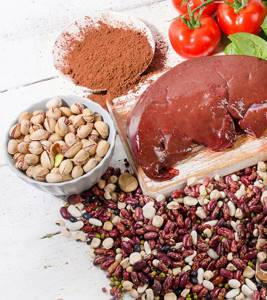
Sometimes the cause of the disease is an unbalanced diet. In this case, the following products will help cope with it:
- red meat;
- liver;
- buckwheat;
- beet;
- black currant;
- plums, apples, peaches;
- pomegranates and prunes;
- dried apricots and rose hips;
- nuts, beans;
- tomatoes;
- baked potatoes with skin.
If the cause of low hemoglobin is only a lack of iron, then with such a diet it will return to normal in 3-4 weeks.
Diet and nutrition for low hemoglobin in women
With anemia, the patient must eat 5 times a day, following a special diet to provide the body with the necessary substances and especially iron. An approximate menu for the day could be like this:
- First breakfast: a plate of millet porridge with the addition of prunes, dried apricots and nuts, as well as a small wheat bun and a glass of freshly squeezed apple juice.
- For second breakfast, you can eat a piece of white bread with natural cheese and drink a glass of strong rosehip infusion.
- The patient's lunch should consist of soup in strong beef broth with vegetables, dried fruit compote, as well as a multi-component vegetable salad with the addition of boiled meat.
- For an afternoon snack, you can eat a fresh salad of berries and fruits (you can simply replace them with individual fruits), crackers, and drink a glass of fresh carrot juice.
- For dinner, it is best to prepare buckwheat porridge with beef, a vegetable salad with the obligatory addition of green peas, and drink a cup of good green or red tea.
It is not recommended to eat at night , but if you really want to snack, you can drink a small glass of fresh kefir, but not more than the specified amount, since consumption of dairy products reduces the level of iron absorption by the body.
Of course, the daily menu can be quite varied, but in any case it must be completely balanced, provide the body with all the necessary substances and contain a large amount of iron.
But with the help of diet alone, even with the strictest adherence to it, it is impossible to eliminate the state of anemia. Normalization of nutrition in this case creates the basis for faster recovery of the body and provides it with the necessary substances for normal existence.
In addition to normalizing nutrition when women have low hemoglobin, they should additionally take medications that increase iron levels , which today are available in different forms, for example, capsules, tablets, injection solutions, syrups. The type of drug, the form of its administration and dosage are determined by the doctor, taking into account the patient’s condition.
In addition to iron supplements, in most cases the doctor prescribes folic acid and vitamin C for about 2-3 months with mandatory monitoring of hemoglobin levels.
A special vitamin cocktail made from freshly squeezed juices of apple, beetroot and carrot in equal parts is considered an excellent way to restore hemoglobin levels. It must be taken before each meal, about half an hour before meals.
